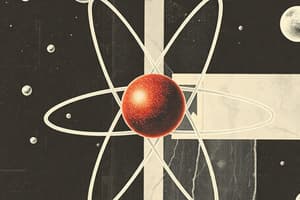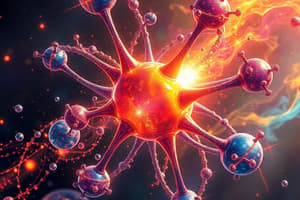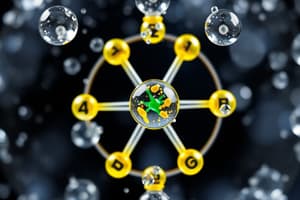Podcast
Questions and Answers
What determines the identity of an element?
What determines the identity of an element?
- Number of electrons
- Number of protons (correct)
- Number of neutrons
- Relative mass
Atoms are neutrally charged because they contain an unequal amount of protons and electrons.
Atoms are neutrally charged because they contain an unequal amount of protons and electrons.
False (B)
What type of ions do metals form when they lose electrons?
What type of ions do metals form when they lose electrons?
cations
Non-metals tend to ______ electrons to achieve a full outer shell, thereby becoming negatively charged.
Non-metals tend to ______ electrons to achieve a full outer shell, thereby becoming negatively charged.
Match the following terms with their definitions in the context of ionic compounds:
Match the following terms with their definitions in the context of ionic compounds:
Which groups on the periodic table are most likely to form ionic bonds?
Which groups on the periodic table are most likely to form ionic bonds?
Ionic bonds involve the sharing of electrons between atoms to achieve stability.
Ionic bonds involve the sharing of electrons between atoms to achieve stability.
What is the electrostatic force like in an ionic bond?
What is the electrostatic force like in an ionic bond?
When naming a binary ionic compound, the metal which forms the ______ is written first.
When naming a binary ionic compound, the metal which forms the ______ is written first.
Match each element with the correct ionic compound naming ending:
Match each element with the correct ionic compound naming ending:
In a chemical formula like $CO_2$, what does the capital letter indicate according to the text?
In a chemical formula like $CO_2$, what does the capital letter indicate according to the text?
Molecules are formed through ionic bonds by metals only.
Molecules are formed through ionic bonds by metals only.
How many diatomic elements are mentioned in the text?
How many diatomic elements are mentioned in the text?
Covalent bonding occurs when atoms ______ valence electrons to form a stable outer electron shell.
Covalent bonding occurs when atoms ______ valence electrons to form a stable outer electron shell.
Match each term to whether it's associated with ionic or covalent bonds:
Match each term to whether it's associated with ionic or covalent bonds:
In naming covalent compounds, which element is written first in the name?
In naming covalent compounds, which element is written first in the name?
The prefix 'mono-' is always added to the first element's name in covalent compounds.
The prefix 'mono-' is always added to the first element's name in covalent compounds.
What suffix is used to denote the number of carbon atoms in alkanes?
What suffix is used to denote the number of carbon atoms in alkanes?
As hydrocarbon chain length increases, boiling point typically ______ due to increased intermolecular forces.
As hydrocarbon chain length increases, boiling point typically ______ due to increased intermolecular forces.
Match the terms with whether the process releases or requires/aborbs energy:
Match the terms with whether the process releases or requires/aborbs energy:
Flashcards
Atoms
Atoms
The tiny building blocks of everything that retain the properties of a substance.
Element
Element
A substance made of only one kind of atom.
Electrons
Electrons
Orbit in shells, negative charge, very small mass (1/1360). Located outside the nucleus.
Neutrons
Neutrons
Signup and view all the flashcards
Protons
Protons
Signup and view all the flashcards
Atomic Number
Atomic Number
Signup and view all the flashcards
Mass number
Mass number
Signup and view all the flashcards
Ions
Ions
Signup and view all the flashcards
Metals and Electron Loss
Metals and Electron Loss
Signup and view all the flashcards
Nonmetals and Electron Gain
Nonmetals and Electron Gain
Signup and view all the flashcards
Ionic bond
Ionic bond
Signup and view all the flashcards
Compound
Compound
Signup and view all the flashcards
Cations
Cations
Signup and view all the flashcards
Anions
Anions
Signup and view all the flashcards
Ionic Compound - Salt
Ionic Compound - Salt
Signup and view all the flashcards
Covalent Bond
Covalent Bond
Signup and view all the flashcards
Molecule
Molecule
Signup and view all the flashcards
Covalent Bonding
Covalent Bonding
Signup and view all the flashcards
Mixture
Mixture
Signup and view all the flashcards
Activation energy
Activation energy
Signup and view all the flashcards
Study Notes
Atomic Structure and Ions
- Atoms are the smallest units of matter that retain a substance's properties.
- Elements consist of only one type of atom; a gold ring is made of gold atoms, a helium balloon contains helium atoms.
Structure of an Atom
- Electrons orbit in shells and have a negative charge and a mass of 1/1360.
- Neutrons are in the nucleus, have a neutral charge, and a relative mass of 1.
- Protons are in the nucleus, have a positive charge, and a relative mass of 1.
Drawing Atoms
- The atomic number indicates the number of protons in an atom.
- The number of electrons equals the number of protons.
- The mass number tells the number of protons plus neutrons in the nucleus.
- The first electron shell holds 2 electrons, and subsequent shells hold 8.
Ions and Ionic Bonds
- Atoms are electrically neutral when containing an equal amount of protons and electrons.
- Ions are electrically charged particles.
- A neutral atom that loses electrons becomes a positive ion.
- A neutral atom that gains electrons becomes a negative ion.
Atoms to Ions
- Atoms gain or lose electrons to achieve a full outer shell (8 electrons).
- Metals lose electrons to become positively charged cations.
- Nonmetals gain electrons to become negatively charged anions.
Metals and Nonmetals
- Metals lose electrons from their outer shell.
- Group 2 metals lose 2 electrons to become +2 ions.
- Nonmetals gain electrons to fill their outer shell.
- Group 7 atoms gain 1 electron to become -1 ions.
Ionic Bonding
- Atoms form ions by donating or accepting electrons through ionic bonding.
- Ionic bonding occurs between positive and negative ions.
- An ionic bond forms a weak electrostatic attraction between positive and negative ions.
- Ionic bonding happens when a metal reacts with a non-metal; the metal gives electrons to the non-metal.
- This typically occurs in groups 1, 2, 6, and 7, with some exceptions in group 3.
- After ionic bonding, atoms become positive and negative ions.
- They achieve the same electronic structure as a noble gas, having a full outer electron shell and held together by strong electrostatic attraction.
- A compound is a pure substance chemically bonded together from multiple elements, such as carbon dioxide and water
Naming Ionic Compounds
- An ionic bond is created when metal ions combine non-metal ions, involving electron transfer.
- Metals form positive ions (cations), and nonmetals form negative ions (anions). The cation is written first.
- In a binary compound of two elements, the second element's name changes to end in IDE.
- When a metal reacts with a nonmetal, it forms an ionic compound, also known as a salt.
- Metals are the first part of the salt's name, hence INE is changed to IDE.
- Converting INE to IDE, the cation is written first.
- For example, the name of the ionic compound of chlorine (anion/nonmetal) and sodium is sodium chloride.
Covalent Bonds
- In chemical formulas, a capital letter indicates the start of each new element.
- A lowercase letter following a capital letter means it is part of the same element, e.g., Cl for Chlorine.
- The formula HCl has two elements, hydrogen and chlorine.
- Co represents the single element cobalt.
- CO represents the compound carbon monoxide.
- Nonmetals react with each other to gain a full outer shell of electrons.
- Molecules are two or more atoms joined by a covalent bond.
- Each atom has a stable, full outer electron shell.
- The 7 diatomic elements are hydrogen, nitrogen, oxygen, fluorine, bromine, and iodine.
- Covalent bonding occurs only between nonmetals and requires atoms to overlap.
- Atoms only draw outer shell electrons and each atom donates the number of electrons needed for the covalent bond.
- Different symbols are used to represent the electrons on each atom.
Naming Covalent Compounds
- In the compound's name, the element furthest to the left on the periodic table is written first.
- In a binary compound, the second element’s name changes to end in IDE.
- Oxygen uses IDE; whenever oxygen is at the end of a binary compound, the ending changes to IDE.
- Use the molecular formula to find number of each type of atom using a prefix, except for one of the first element.
- Mono- is not added to the first element’s name, but it does apply to the second element.
- Drop the "a" or "o" at the prefix's end when the element name begins with a vowel; four oxygen atoms is tetroxide, not tetraoxide.
- The element that appears first is usually furthermost left on the periodic table, but carbon always appears first, for example, CH4..
- In a formula like NH#, hydrogen appears after nitrogen.
Classifying Compounds
- Crude oil is a mixture of compounds.
- A mixture contains two or more elements or compounds not chemically joined.
- Most compounds in crude oil are hydrocarbons.
Naming Alkanes
- The prefix of an alkane's name depends on the number of carbon atoms.
- All alkanes end in ANE.
Boiling Point of Hydrocarbons
- Boiling point increases with hydrocarbon size because the larger molecules are held together by weak intermolecular forces.
- More energy is needed to overcome these forces.
Viscosity of Hydrocarbons
- Viscosity measures how thick a liquid is.
- Low viscosity liquids like water flow easily.
- High viscosity liquids like treacle do not flow easily.
Exothermic and Endothermic Reactions
- Exothermic reactions release energy, causing the temperature to increase.
- Endothermic reactions absorb energy, causing the temperature to decrease.
Solutes, Solvents, and Solutions
- Water is a polar molecule, sharing electrons in covalent bonds between oxygen and hydrogen.
- Oxygen attracts electrons more strongly, resulting in a slight negative charge near the oxygen atom.
- Neutral molecules with positive and negative areas are polar molecules.
- Water molecules attract each other due to the positive end of one molecule attracting the negative end of another.
Precipitates
- When salts dissolve in water, they form positive or negative ions.
- Mixing solutions of two different salts can cause one of the positive ions to join with one of the negative ions to form a solid that does not dissolve, called a precipitate.
- Precipitation makes the solution opaque and sometimes colourful.
Solubility Rules
- Chemists use solubility rules to predict if a product will be soluble.
- If a product is insoluble, a precipitate forms.
- All nitrates and acetates are soluble.
- All salts of ammonium, lithium, sodium, and potassium are soluble.
Chemical Reactions
- Magnesium + Oxygen → Magnesium Oxide
- Reactants are the chemicals at the start of a reaction.
- Products are the chemicals at the end of the reaction.
Rates of Reactions
- All rates of reaction graphs level off when no more reactant is used or product made, indicating a reactant has run out.
- Collision is necessary for a reaction to happen, in which particles from the reactant chemicals must collide.
Collision Theory
- Particles must have enough energy to react upon collision.
- The minimum energy needed is the activation energy.
Concentration
- Higher reactant concentration leads to more particles in the same volume.
- This causes more frequent collisions and increases reaction rate.
Surface Area
- Increasing the surface area of a solid reactant increases the reaction rate.
- This can be achieved by using small chunks or a powder.
Temperature
- Increasing the temperature gives particles more kinetic energy making them move around faster.
- This leads to more frequent and energetic collisions.
Catalyst
- Catalysts provide an alternative reaction pathway with a lower activation energy, increasing the reaction rate without increasing collision frequency.
- Catalysts are not used up in the reaction, allowing them to be used again.
Studying That Suits You
Use AI to generate personalized quizzes and flashcards to suit your learning preferences.




